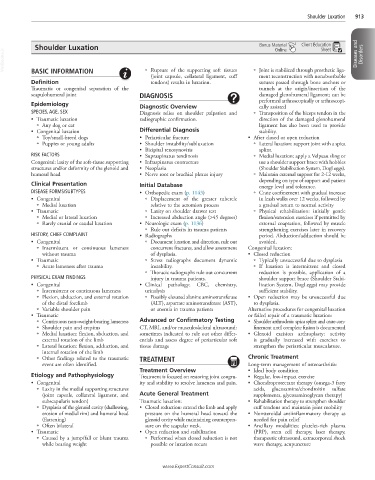Page 1825 - Cote clinical veterinary advisor dogs and cats 4th
P. 1825
Shoulder Luxation 913
Shoulder Luxation Bonus Material Client Education
Sheet
Online
VetBooks.ir Diseases and Disorders
BASIC INFORMATION
○ Rupture of the supporting soft tissues
(joint capsule, collateral ligament, cuff ○ Joint is stabilized through prosthetic liga-
ment reconstruction with nonabsorbable
Definition tendons) results in luxation. sutures passed through bone anchors or
Traumatic or congenital separation of the tunnels at the origin/insertion of the
scapulohumeral joint DIAGNOSIS damaged glenohumeral ligament; can be
Epidemiology Diagnostic Overview performed arthroscopically or arthroscopi-
cally assisted
SPECIES, AGE, SEX Diagnosis relies on shoulder palpation and ○ Transposition of the biceps tendon in the
• Traumatic luxation radiographic confirmation. direction of the damaged glenohumeral
○ Any dog or cat ligament has also been used to provide
• Congenital luxation Differential Diagnosis stability.
○ Toy/small-breed dogs • Periarticular fracture • After closed or open reduction
○ Puppies or young adults • Shoulder instability/subluxation ○ Lateral luxation: support joint with a spica
• Bicipital tenosynovitis splint.
RISK FACTORS • Supraspinatus tendinosis ○ Medial luxation: apply a Velpeau sling or
Congenital: laxity of the soft-tissue supporting • Infraspinatus contracture use a shoulder support brace with hobbles
structures and/or deformity of the glenoid and • Neoplasia (Shoulder Stabilization System, DogLeggs).
humeral head • Nerve root or brachial plexus injury ○ Maintain external support for 2-12 weeks,
depending on type of support and patient
Clinical Presentation Initial Database energy level and tolerance.
DISEASE FORMS/SUBTYPES • Orthopedic exam (p. 1143) ○ Crate confinement with gradual increase
• Congenital ○ Displacement of the greater tubercle in leash walks over 12 weeks, followed by
○ Medial luxation relative to the acromion process a gradual return to normal activity
• Traumatic ○ Laxity on shoulder drawer test ○ Physical rehabilitation: initially gentle
○ Medial or lateral luxation ○ Increased abduction angle (>45 degrees) flexion/extension exercises if permitted by
○ Rarely cranial or caudal luxation • Neurologic exam (p. 1136) external coaptation, followed by muscle
○ Rule out deficits in trauma patients strengthening exercises later in recovery
HISTORY, CHIEF COMPLAINT • Radiographs period. Abduction/adduction should be
• Congenital ○ Document luxation and direction, rule out avoided.
○ Intermittent or continuous lameness concurrent fractures, and allow assessment Congenital luxation:
without trauma of dysplasia. • Closed reduction
• Traumatic ○ Stress radiographs document dynamic ○ Typically unsuccessful due to dysplasia
○ Acute lameness after trauma instability. ○ If luxation is intermittent and closed
○ Thoracic radiographs rule out concurrent reduction is possible, application of a
PHYSICAL EXAM FINDINGS injury in trauma patients. shoulder support brace (Shoulder Stabi-
• Congenital • Clinical pathology: CBC, chemistry, lization System, DogLeggs) may provide
○ Intermittent or continuous lameness urinalysis sufficient stability.
○ Flexion, abduction, and external rotation ○ Possibly elevated alanine aminotransferase • Open reduction may be unsuccessful due
of the distal forelimb (ALT), aspartate aminotransferase (AST), to dysplasia.
○ Variable shoulder pain or anemia in trauma patients Alternative procedures for congenital luxation
• Traumatic or failed repair of a traumatic luxation:
○ Continuous non–weight-bearing lameness Advanced or Confirmatory Testing • Shoulder arthrodesis: spica splint and crate con-
○ Shoulder pain and crepitus CT, MRI, and/or musculoskeletal ultrasound: finement until complete fusion is documented
○ Medial luxation: flexion, abduction, and sometimes indicated to rule out other differ- • Glenoid excision arthroplasty: activity
external rotation of the limb entials and assess degree of periarticular soft is gradually increased with exercises to
○ Lateral luxation: flexion, adduction, and tissue damage strengthen the periarticular musculature.
internal rotation of the limb
○ Other findings related to the traumatic TREATMENT Chronic Treatment
event are often identified. Long-term management of osteoarthritis:
Treatment Overview • Ideal body condition
Etiology and Pathophysiology Treatment is focused on restoring joint congru- • Regular, low-impact exercise
• Congenital ity and stability to resolve lameness and pain. • Chondroprotectant therapy (omega-3 fatty
○ Laxity in the medial supporting structures acids, glucosamine/chondroitin sulfate
(joint capsule, collateral ligament, and Acute General Treatment supplements, glycosaminoglycan therapy)
subscapularis tendon) Traumatic luxation: • Rehabilitation therapy to strengthen shoulder
○ Dysplasia of the glenoid cavity (shallowing, • Closed reduction: extend the limb and apply cuff tendons and maintain joint mobility
erosion of medial rim) and humeral head pressure on the humeral head toward the • Nonsteroidal antiinflammatory therapy as
(flattening) glenoid cavity while maintaining counterpres- needed for pain relief
○ Often bilateral sure on the scapular neck. • Ancillary modalities: platelet-rich plasma
• Traumatic • Open reduction and stabilization (PRP), stem cell therapy, laser therapy,
○ Caused by a jump/fall or blunt trauma ○ Performed when closed reduction is not therapeutic ultrasound, extracorporeal shock
while bearing weight possible or luxation recurs wave therapy, acupuncture
www.ExpertConsult.com

